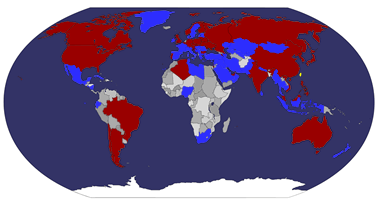 Snoopy is a fictional character in the long-running comic strip Peanuts, by Charles M. Schulz. He is Charlie Brown's pet beagle. Snoopy began his life in the strip as a fairly ordinary dog, but eventually evolved into perhaps the strip's most dynamic character — and among the most recognizable comic characters in the world. The original drawings of Snoopy were "slightly patterned" after Spike, one of Schulz's childhood dogs.
Snoopy is a fictional character in the long-running comic strip Peanuts, by Charles M. Schulz. He is Charlie Brown's pet beagle. Snoopy began his life in the strip as a fairly ordinary dog, but eventually evolved into perhaps the strip's most dynamic character — and among the most recognizable comic characters in the world. The original drawings of Snoopy were "slightly patterned" after Spike, one of Schulz's childhood dogs.Snoopy, whose fictional birthday has been established as October 4, made his first appearance in the strip of October 4, 1950, two days after the strip premiered. He was first identified by name on November 10. Schulz was originally going to call him "Sniffy" (as described in the 25th anniversary book), until he discovered that name was used in a different comic strip. He changed it to "Snoopy" after remembering that his late mother Dena Schulz had commented that if their family were ever to acquire a third dog, it should be called Snoopy, an affectionate term in Norwegian.
In earlier strips it is not clear who Snoopy belongs to; for instance in the February 2, 1951 strip, Charlie Brown accuses Snoopy of following him, only to be told by Patty that Snoopy isn't following Charlie Brown but merely lives in the same direction. Indeed many early strips show Snoopy interacting with Shermy (who is shown in one early strip running with Snoopy on his leash) and Patty without Charlie Brown, making Snoopy appear to belong to all of the neighborhood kids, similar to the dog Pete in the Our Gang comedies, who is everyone's dog. (Note: in this era, it was common for dogs to roam their local area and congregate with local children, and then return to their respective homes). Later, Charlie Brown states that his parents bought Snoopy for him at the Daisy Hill Puppy Farm, after another boy had dumped sand on him while playing in a sandbox.
Snoopy was a silent character for the first two years of his existence, but on May 27, 1952 he verbalized his thoughts to readers for the first time in a thought balloon; Schulz would utilize this device for nearly all of the character's appearances in the strip thereafter. At first, Snoopy acted as a normal dog, and would only think in simple one-word phrases (such as "FOOD!"), but then became more articulate.
In addition to Snoopy's ability to "speak" his thoughts to the reader, many of the human characters in Peanuts have the uncanny knack of reading his thoughts and responding to them. In the animated Peanuts films and television specials, Snoopy's thoughts are not verbalized; his moods are instead conveyed through growls, sobs, laughter, monosyllabic utterances such as "bleah," "hey," etc., as well as through pantomime. The only exceptions are in the animated adaptations of You're a Good Man, Charlie Brown and Snoopy!!! The Musical, in which Snoopy's thoughts are verbalized through voice overs (by Robert Towers and Cam Clarke, respectively). Animation producer Bill Meléndez voiced both Snoopy and (eventually) Woodstock in numerous television specials from 1965 to 2006. He is also featured on his own currency, the Snoopybuck.
Oddly enough, the first time a beagle was mentioned in the strip (December 5, 1960), Snoopy denied being one. As Snoopy dozed, Charlie Brown paraphrased Gertrude Stein: "Beagles on the grass, alas." To this, Snoopy replied, "I ain't no stupid beagle!" (Years later, Snoopy would paraphrase the Stein expression himself: "Birds in the grass, alas; beagle on the roof, aloof.")
As the series progressed, Snoopy became a more human-like dog. His character is that of a dog who thinks he is a person (or who sometimes forgets he is a dog). In one Peanuts strip, Sally had to do a report on animals for school, and requested Snoopy's help. But Snoopy was reluctant. "How can I help?" he thought. "I don't know any animals."
Many of Peanuts' memorable moments come in Snoopy's daydream as a writer: his eternal opener on the typewriter "It was a dark and stormy night..." is taken from Edward George Bulwer-Lytton's 1830 novel Paul Clifford. Almost all his submissions are rejected by potential publishers, who eventually resort to rude dismissals and cruel jokes to attempt to prevent being bothered by Snoopy. The contrast between Snoopy's existence in a dream world and Charlie Brown's in the real world is central to the humour and philosophy of Peanuts (e.g., the Peanuts book title Life's a Dream, Charlie Brown).
Schulz summed up Snoopy's character in a 1997 interview: "He has to retreat into his fanciful world in order to survive. Otherwise, he leads kind of a dull, miserable life. I don't envy dogs the lives they have to live."
Snoopy est le beagle (et non pas un bull-terrier comme on pourrait croire) de Charlie Brown et est, avec lui, le personnage central des Peanuts. Au fur à mesure du comic, son comportement devient « humain » : il se met à marcher sur ses deux pattes, à penser et à philosopher.
Il a des habitudes plutôt extravagantes, comme celle de dormir sur le toit de sa niche et vit dans un monde fantaisiste, se prenant pour un astronaute (le premier beagle à avoir marché sur la lune, avant même la mission Apollo 10 (laquelle adoptera les noms de Charlie Brown, pour le module de commande et de Snoopy, pour le module lunaire), un aviateur de la Première Guerre mondiale, perpétuellement aux prises avec l'as allemand des airs Manfred von Richthofen, le Baron Rouge, le joueur de billard Eddie Vite-fait du film L'Arnaqueur, le légionnaire Beau Geste, un célèbre écrivain, un grand joueur de hockey, un joueur de tennis, un scout, etc.
Il a de nombreux frères et sœurs, dont Spike, Andy, Olaf et Tupfen. Son meilleur ami est Woodstock, un petit oiseau jaune, contraint, à l'occasion de lui servir de secrétaire.









.jpg)























 taiwan
taiwan  cover or postcard
cover or postcard  FDC
FDC 






























































































No comments:
Post a Comment